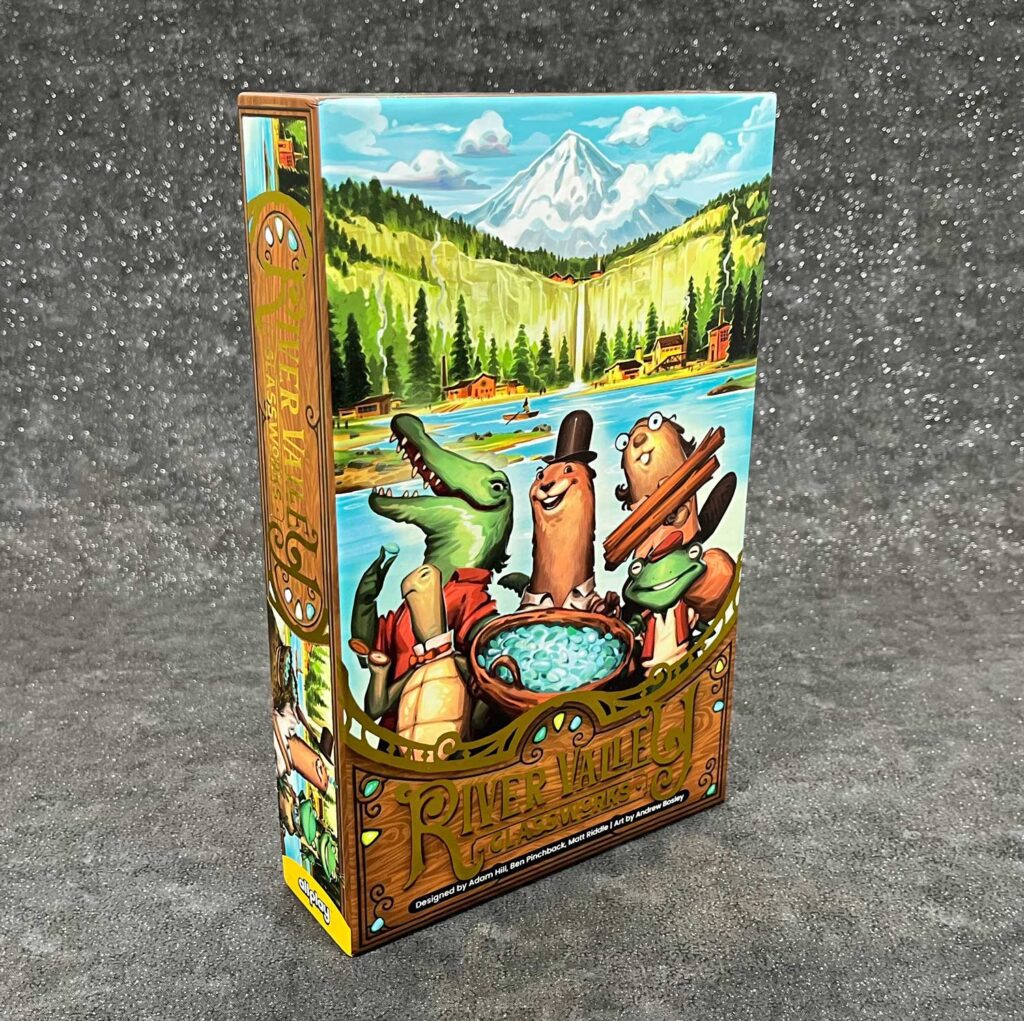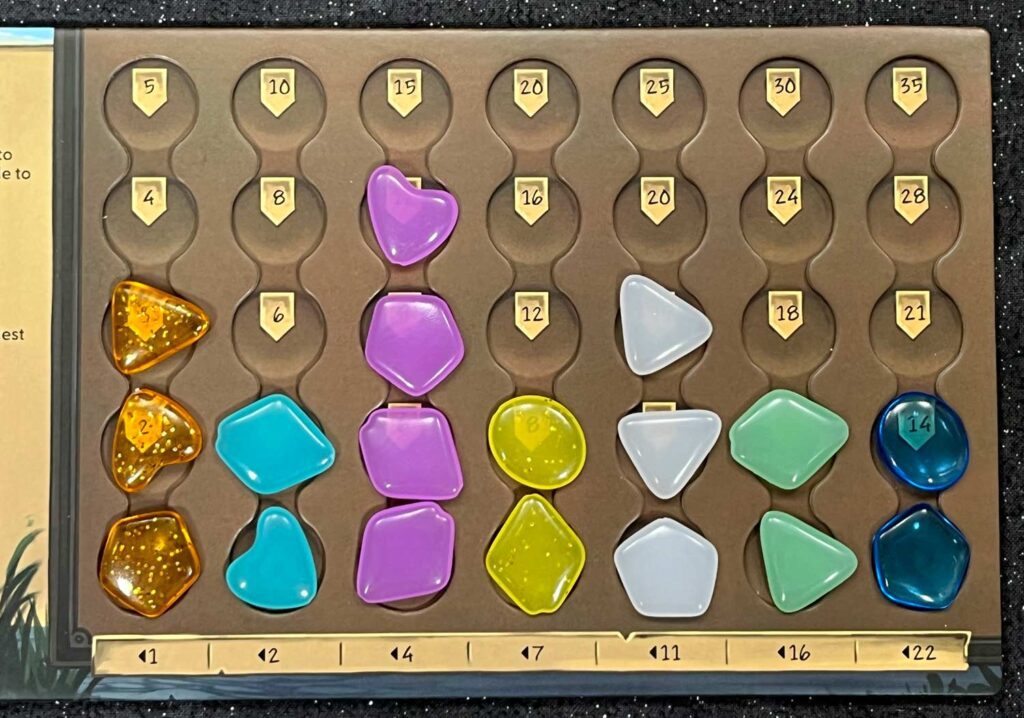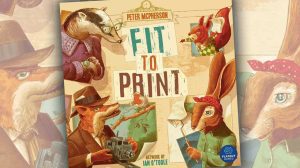Cozy.
It’s an up-and-coming literary term these days; used to describe a softer sort of book: fantasies, mysteries, etc. where the stakes are relatively low, and readers are given plenty of reasons to fall in love with the characters and their lives. Some of my favorites are Becky Chambers’ sci-fi novel The Long Way to a Small, Angry Planet, Travis Baldree’s Legends & Lattes, and Mia P. Manansala’s Tita Rosie’s Kitchen mystery series. But in the past few years, board games have been picking up this flag and proudly waving it. With titles like Calico (a game about making quilts for cats), The Whatnot Cabinet (collecting trinkets and arranging them), Flamecraft (artisan dragon helpers in a small village), and now River Valley Glassworks (a game about collecting river glass).
You might know that I’m a big fan of other games from this team: including French Quarter, and Three Sisters. I was so interested in River Valley Glassworks that I backed it on Kickstarter. This game is aimed squarely at games like Azul, but should resonate with gamers of all ages and experience levels. So let me tell you why I love it.

River Valley Glassworks Overview
In River Valley Glassworks players are collecting smooth glass pieces from the river, in 6 different shapes and 9 different colors. These pieces get placed onto your workbench where you’ll earn points for collecting both a wide range of colors as well as a lot of any 2 specific colors. Colors have different rarities with white and purple being the most common and sparkly yellow and orange being the most rare.

How to Play River Valley Glassworks
One of the things I love about the catalog of Allplay games is that many of their titles are simple. That’s not to say “easy” per se, but easy to teach and quick to play. Games like Dandelions and Mountain Goats are elegant in their simplicity; and those of you who read my reviews know that’s my sweet spot. And I’m excited to say that River Valley Glassworks fits perfectly in that lineup.
On your turn you have only two choices: place a piece of glass from your satchel on to one of the river tiles and gather nearby glass pieces (placing them into your glassworks), or draw exactly 4 pieces from the lake to replenish your satchel. That’s it. Of course there’s slightly more to the decision space than that: timing and awareness both play big roles in this game.
In order to gather glass from the river, select a shape from your satchel and place it onto a river tile with a matching shape. Then select all the glass from one of the tiles on either side and add those pieces to your board. This action is the soul of the game, and the one you’ll focus most of your attention on. You want to fill up as many rows as possible, and to do that you need different colors. But you also want to “go big” on 2 different colors in order to really rack up the points (more on that in a minute).
When drawing from the lake, pick up exactly 4 pieces and add them to your satchel. Keep in mind that any time you collect glass (from lake or river) it either goes onto your board, or into the overflow area, which will score you negative points at the end of the game.

After a player places their 17th piece of glass on their board, the game’s end is triggered and everyone gets one final turn.
To determine the winner, first you score all rows. Each row scores points based on how much you filled it up from left to right, with the values printed at the bottom of your board. Then you score your two tallest columns, earning the points printed on the highest spot reached. If there’s a tie, you score the column on the left.

Final Thoughts on River Valley Glassworks
So that’s River Valley Glassworks. It’s fast, fun, and adorable, but it’s not just a pretty face–this game has some depth to it, to go along with Allplay’s killer production quality. I backed the Retail pledge level on Kickstarter, but the review copy I received from the publisher is the Deluxe version which contains the fully illustrated play mat, clear river tiles (the retail version will be cardboard), screen printed critters, double layer player boards, and a swanky gold foil logo text.
I’ve played it now with every player count except for 5, and everyone so far has loved it. In fact we’ve wound up talking about the game for 10-15 minutes afterwards, turning it over in our heads as to just why it’s so appealing. In a nutshell, it doesn’t overstay its welcome. It does a thing, and does it well.
We’ve all loved the choices that River Valley Glassworks presents. Should you go for rare glass first in order to pad the left side of your board where the column scoring is weak? But what if that allows another player to acquire glass more quickly? Do you pull from the lake with only 1 piece of glass left or should you wait until you have nothing? Are you paying attention to what pieces other players have? If you know that Lauren or Grace don’t have the right shapes to pick up the pieces you want, then you might be able to make better choices. Note that I’m not talking long term strategy here—the game is over in under 30 minutes. In fact the speed at which one player hits 17 pieces of glass comes way faster than you think it will. And that’s really my only criticism of the game: it can be over too quickly. I’m over here building up a perfect workbench and Henry’s rushing the game end.
In addition to the Deluxe game, the publisher also included the River Glass & Other Sundries Expansion. This is a deck of cards containing 6 mini modules which can be mixed and matched with the base game. Each module contains a card for each player and focuses on a different aspect of glass collection. In the Lake Diving module, each player is dealt a card containing a different shape; at the end of the game you’ll earn bonus points for each one of those shapes you have on your board. In the Flooded Market module, each player is dealt a card with a color: and you try to avoid collecting that color. The other 4 modules are similar, but each provides just a slight twist which makes the game different with each play.
So do I love River Valley Glassworks? I definitely do, for all the reasons I listed above. But more than just the gameplay, I love the idea of coziness in board games. There are far more “casual” board gamers than there are hardcore. And if a specific theme can grab someone’s attention and draw them more deeply into the hobby then I’m all for it.
In the meantime I’ve got some glass to collect.












Add Comment